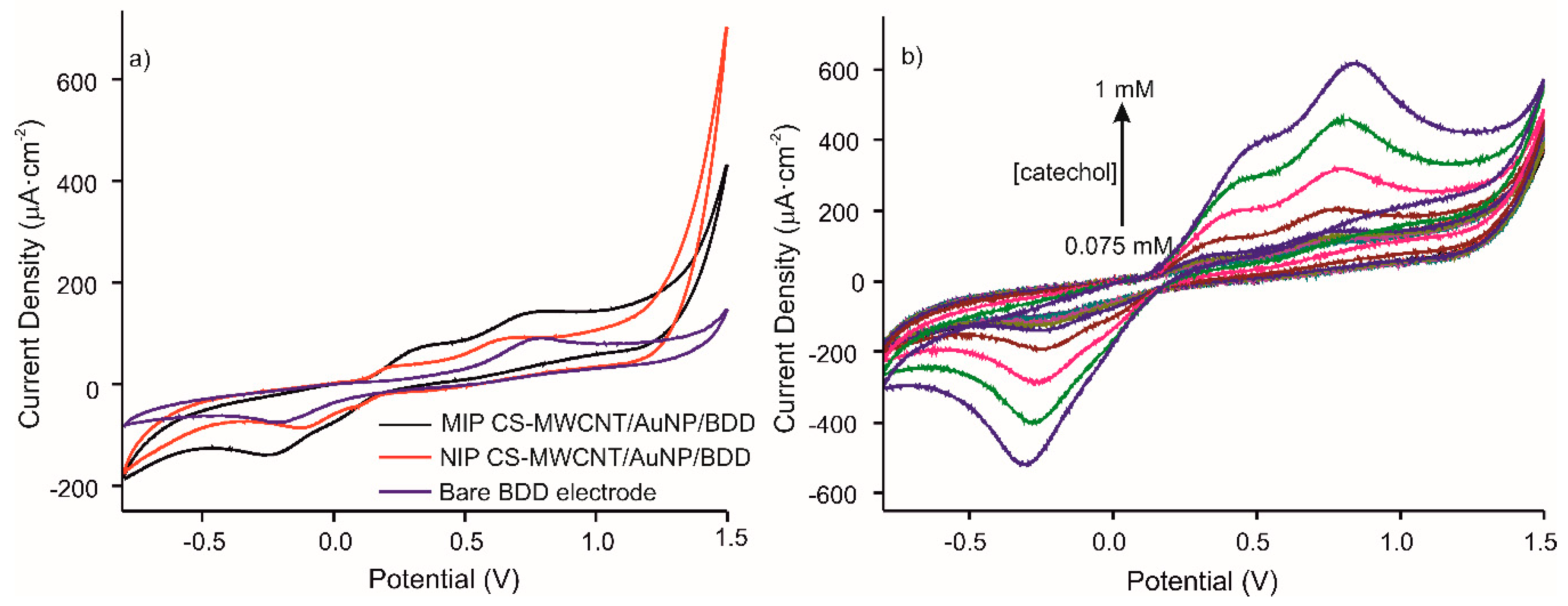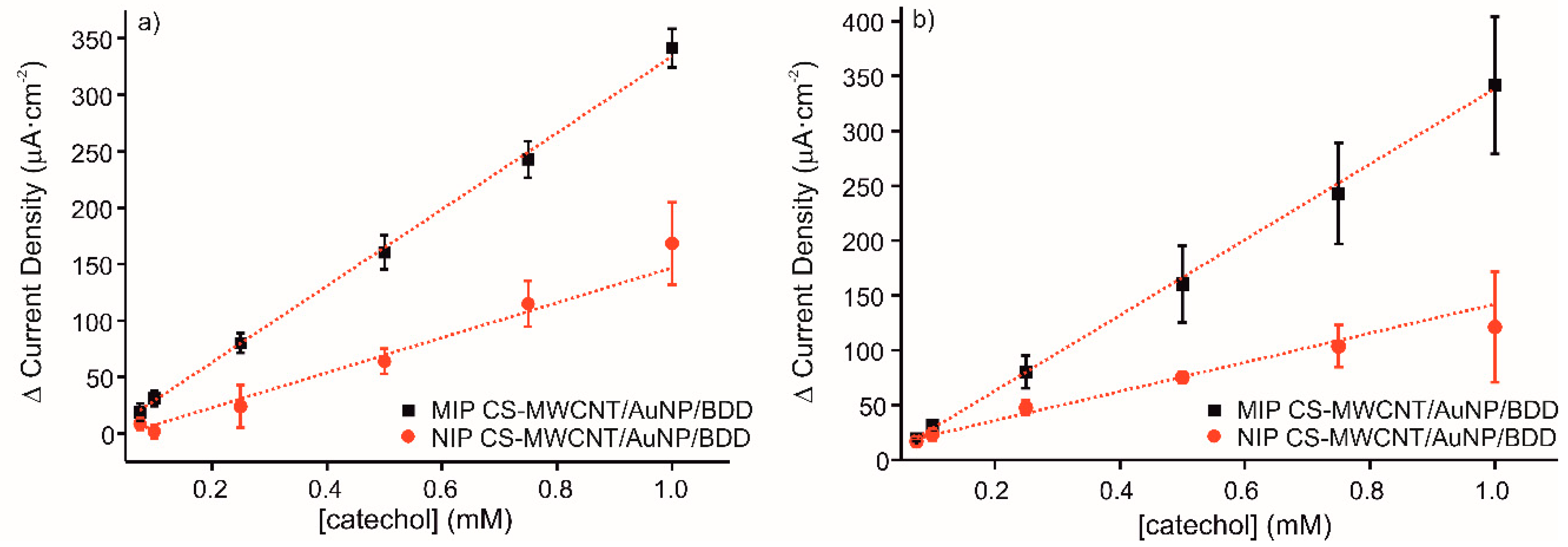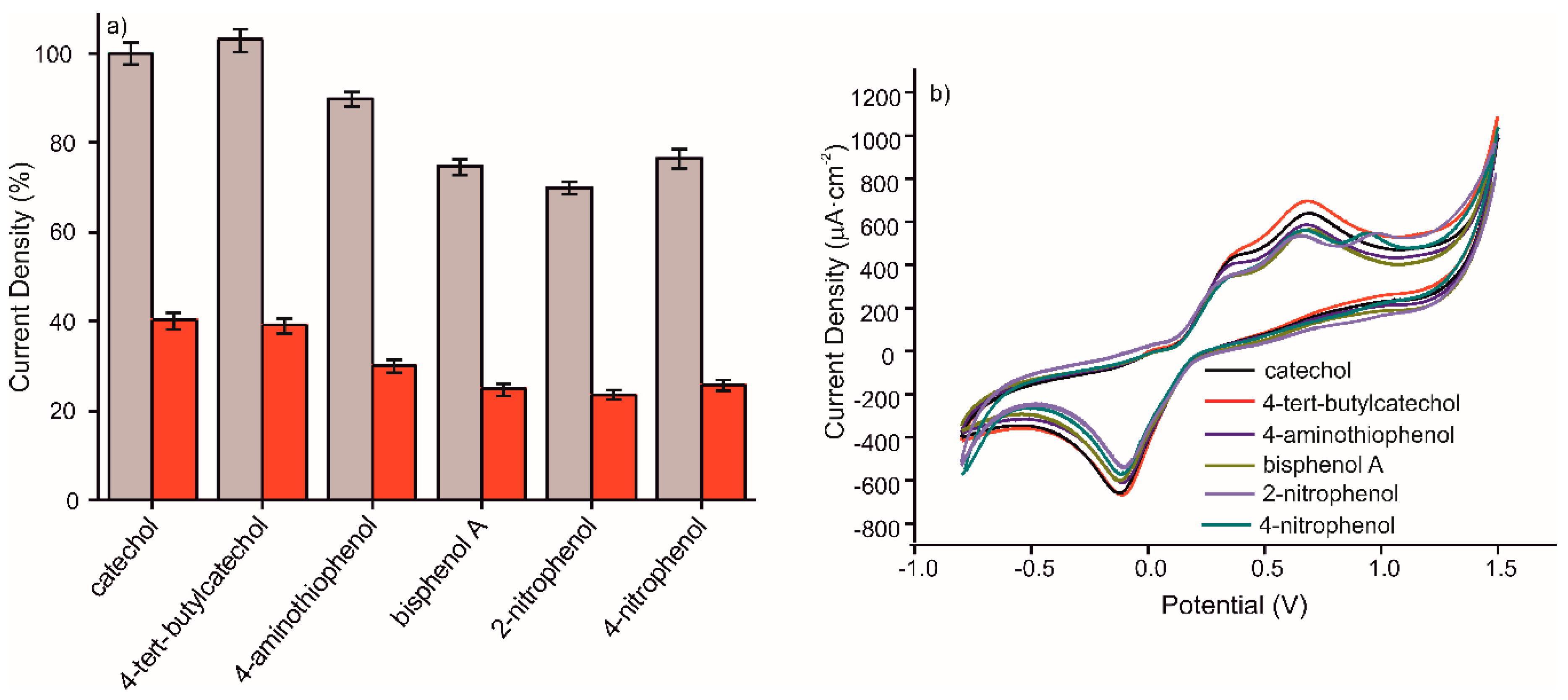Voltammetric Sensor Based on Molecularly Imprinted Chitosan-Carbon Nanotubes Decorated with Gold Nanoparticles Nanocomposite Deposited on Boron-Doped Diamond Electrodes for Catechol Detection
Abstract
1. Introduction
2. Materials and Methods
2.1. Chemicals
2.2. Instruments
2.3. Preparation of MWCNT/AuNP
2.4. Preparation of CS-MWCNT/AuNP
2.5. Preparation of MIP CS-MWCNT/AuNP Nanocomposite Modified BDD Electrode
2.6. Wine Sample Pretreatment
3. Results and Discussion
3.1. Morphological Characterization of MIP CS-MWCNT/AuNP Nanocomposite
3.2. Optimization of MWCNT/AuNP Concentration
3.3. Electrochemical Characterization of the MIP Cs-MWCNT/AuNP Nanocomposite/BDD Sensors
3.4. Sensitivity, Reproducibility, Stability, and Selectivity
3.5. Detection of Catechol in a Complex Matrix
4. Conclusions
Author Contributions
Funding
Acknowledgments
Conflicts of Interest
References
- Datta, S.; Kanjilal, B.; Sarkar, P. Electrochemical Sensor for Detection of Polyphenols in Tea and Wine with Differential Pulse Voltammetry and Electrochemical Impedance Spectroscopy Utilizing Tyrosinase and Gold Nanoparticles Decorated Biomembrane. J. Electrochem. Soc. 2017, 164, 118–126. [Google Scholar] [CrossRef]
- Makhotkina, O.; Kilmartin, P.A. The use of cyclic voltammetry for wine analysis: Determination of polyphenols and free sulfur dioxide. Anal. Chim. Acta 2010, 668, 155–165. [Google Scholar] [CrossRef] [PubMed]
- Asan, A.; Isildak, I. Determination of major phenolic compounds in water by reversed-phase liquid chromatography after pre-column derivatization with benzoyl chloride. J. Chromatogr. A 2003, 988, 145–149. [Google Scholar] [CrossRef]
- Stratil, P.; Klejdus, B.; Kubáň, V. Determination of totalcontent of phenolic compounds and their antioxidantactivity in vegetables–evaluation of spectrophotometricmethods. J. Agric. Food Chem. 2006, 54, 607–616. [Google Scholar] [CrossRef]
- Keshvari, F.; Bahram, M. Selective, sensitive and reliable colorimetric sensor for catechol detection based on anti-aggregation of unmodified gold nanoparticles utilizing boronic acid–diol reaction: optimization by experimental design methodology. J. Iran. Chem. Soc. 2017, 14, 977–984. [Google Scholar] [CrossRef]
- Yue, M.; Lin, Q.; Xu, J.; Jiang, T. Ionic liquid-based headspace in-tube liquid-phase microextraction coupled with CE for sensitive detection of phenols. Electrophoresis 2018, 39, 1771–1776. [Google Scholar] [CrossRef]
- Ibarra-escutia, P.; Juarez, J.; Calas-blanchard, C.; Louis, J.; Ramírez-silva, M.T. Amperometric biosensor based on a high resolution photopolymer deposited onto a screen-printed electrode for phenolic compounds monitoring in tea infusions. Talanta 2010, 81, 1636–1642. [Google Scholar] [CrossRef]
- Rodríguez-méndez, M.L.; Gay, M.D.; Saja, J.A.; Mu, R. Multisensor system based on bisphthalocyanine nanowires for the detection of antioxidants. Electrochim. Acta 2012, 68, 88–94. [Google Scholar]
- Kilmartin, P.A.; Zou, H.; Waterhouse, A.L. A Cyclic Voltammetry Method Suitable for Characterizing Antioxidant Properties of Wine and Wine Phenolics. J. Agric. Food Chem. 2001, 49, 1957–1965. [Google Scholar] [CrossRef]
- Fu, Y.; Lin, Y.; Chen, T.; Wang, L. Study on the polyfurfural film modified glassy carbon electrode and its application in polyphenols determination. J. Electroanal. Chem. 2012, 687, 25–29. [Google Scholar] [CrossRef]
- Giuliani, E.; Fernandes, R.; Brazaca, L.C.; Rodríguez-mendez, M.L.; Saja, J.A.; Zucolotto, V. Biosensors and Bioelectronics Immobilization of lutetium bisphthalocyanine in nanostructured biomimetic sensors using the LbL technique for phenol detection. Biosens. Bioelectron. 2011, 26, 4715–4719. [Google Scholar]
- Alessio, P.; Pavinatto, F.J.; Oliveira, N., Jr.; De Saja, J.A.; Constantino, C.J.L.; Rodriguez-Mendez, M.L. Detection of catechol using mixed Langmuir—Blodgett films of a phospholipid and phthalocyanines as voltammetric sensors. Analyst 2010, 10, 2591–2599. [Google Scholar] [CrossRef] [PubMed]
- Maikap, A.; Mukherjee, K.; Mondal, B.; Mandal, N. Zinc oxide thin film based nonenzymatic electrochemical sensor for the detection of trace level catechol. RSC Adv. 2016, 6, 64611–64616. [Google Scholar] [CrossRef]
- Ahmad, O.S.; Bedwell, T.S.; Esen, C.; Garcia-cruz, A.; Piletsky, A.; Le, L. Molecularly Imprinted Polymers in Electrochemical and Optical Sensors. Trends Biotechnol. 2018, 37, 294–309. [Google Scholar] [CrossRef] [PubMed]
- Gopalan, A.; Komathi, S.; Muthuchamy, N.; Lee, K.; Whitcombe, M.J.; Dhana, L.; Sai-anand, G. Progress in Polymer Science Functionalized conjugated polymers for sensing and molecular imprinting applications. Prog. Polym. Sci. 2019, 88, 1–129. [Google Scholar]
- Maciel, J.V.; Durigon, A.M.M.; Souza, M.; Quadrado, R.F.N.; Fajardo, R. Polysaccharides derived from natural sources applied to the development of chemically modified electrodes for environmental applications: A review. Trends. Environ. Anal. 2019, 22, e00062. [Google Scholar] [CrossRef]
- Zaidi, S.A. Chemical Development of molecular imprinted polymers based strategies for the determination of Dopamine. Sens. Actuators B Chem. 2018, 265, 488–497. [Google Scholar] [CrossRef]
- Ou, Y.; Qin, C.; Tsen, W.C.; Wen, S.; Wang, J. Chitosan—Based composite membranes containing chitosan—Coated carbon nanotubes for polymer electrolyte membranes. Polym. Adv. Technol. 2018, 29, 612–622. [Google Scholar] [CrossRef]
- Meng, X.; Guo, W.; Qin, X.; Liu, Y.; Zhu, X.; Pei, M. A molecularly imprinted electrochemical sensor based on gold nanoparticles and multiwalled carbon nanotube—Chitosan for the detection of tryptamine. RSC Adv. 2014, 4, 38649–38654. [Google Scholar] [CrossRef]
- Zhou, Y.; Zhi, J. Development of an amperometric biosensor based on covalent immobilization of tyrosinase on a boron-doped diamond electrode. Electrochem. Commun. 2006, 8, 1811–1816. [Google Scholar] [CrossRef]
- Luong, J.H.T.; Male, B.; Glennon, J.D. Boron-doped diamond electrode: synthesis, characterization, functionalization and analytical applications. Analyst. 2009, 134, 1965–1979. [Google Scholar] [CrossRef]
- Salvo-Comino, C.; Rassas, I.; Minot, S.; Bessueille, F.; Rodriguez-Mendez, M.L.; Errachid, A.; Jaffrezic-Renault, N. Voltammetric sensor based on electrodeposited molecularly imprinted chitosan film on BDD electrodes for catechol detection in buffer and in wine samples. Mater. Sci. Eng. C 2020, 110, 110667. [Google Scholar] [CrossRef]
- Turkevich, J.; Stevenson, P.C.; Hillier, J. A study of the nucleation and growth processes in the synthesis of nanoparticles. Discuss. Faraday Soc. 1951, 11, 55–75. [Google Scholar] [CrossRef]
- Carpay, F.M.A.; Cense, W.A. Controlled nucleation for the regulation of the particle size in monodisperse gold suspensions. Nat. Phys. Sci. 1973, 241, 20–22. [Google Scholar]
- David, M.; Arab, M.; Martino, C.; Delmas, L.; Guinneton, F.; Gavarri, J. Carbon nanotubes/ceria composite layers deposited on surface acoustic wave devices for gas detection at room temperature. Thin Solid Films 2012, 520, 4786–4791. [Google Scholar] [CrossRef]
- Li, Y.; Li, Z.; Liu, H.; Chen, S.; Guo, X.; Lin, M.; Li, F. A Portable Electrochemical Platform Integrated with a 3D AuNPs/CNTs Sponge for Point-of-Care Testing of Neurotransmitters. J. Electrochem. Soc. 2019, 166, 524–531. [Google Scholar] [CrossRef]
- Rao, H.; Liu, Y.; Zhong, J.; Zhang, Z.; Zhao, X.; Liu, X.; Jiang, Y.; Zou, P.; Wang, X.; Wang, Y. Gold nanoparticle/chitosan@ N, S co-doped multiwalled carbon nanotubes sensor: fabrication, characterization, and electrochemical detection of catechol and nitrite. ACS Sustain. Chem. Eng. 2017, 5, 10926–10939. [Google Scholar] [CrossRef]
- Mlika, R.; Rouis, A.; Bonnamour, I.; Ben Ouada, H. Impedance spectroscopic investigation of the effect of thin azo-calix [4] arene film type on the cation sensitivity of the gold electrodes. Mater. Sci. Eng. C 2011, 31, 1466–1471. [Google Scholar] [CrossRef]
- Wei, M.; Liu, Y.; Gu, Z.; Liu, Z. Electrochemical Detection of Catechol on Boron-doped Diamond Electrode Modified with Au/TiO2 Nanorod Composite. J. Chin. Chem. Soc.-Taip. 2011, 58, 516–521. [Google Scholar] [CrossRef]
- Lv, M.; Wei, M.; Rong, F.; Terashima, C.; Fujishima, A.; Gu, Z. Electrochemical Detection of Catechol Based on As-Grown and Nanograss Array Boron-Doped Diamond Electrodes. Electroanalysis 2010, 22, 199–203. [Google Scholar] [CrossRef]







| Sensor Description | Electrochemical Technique | Sensitivity (µA mM−1·cm−2) | LOD (M) | Catechol Range (µM) | Ref. |
|---|---|---|---|---|---|
| CS-MWCNT/AuNP nanocomposite/BDD sensor | Voltammetry | 339.05 | 3.6 × 10−5 | 75–1000 | This work |
| Electrodeposited CS-MIP/BDD sensor | Voltammetry | 3972.00 | 6.9 × 10−7 | 0–80 | [22] |
| Au/TiO2 BDD electrode | Voltammetry | 51.58 | 1.4 × 10−6 | 5–200 | [29] |
| Nanograss array BDD electrode | Amperometry | 719.71 | 6.9 × 10−7 | 0–80 | [30] |
© 2020 by the authors. Licensee MDPI, Basel, Switzerland. This article is an open access article distributed under the terms and conditions of the Creative Commons Attribution (CC BY) license (http://creativecommons.org/licenses/by/4.0/).
Share and Cite
Salvo-Comino, C.; Rassas, I.; Minot, S.; Bessueille, F.; Arab, M.; Chevallier, V.; Rodriguez-Mendez, M.L.; Errachid, A.; Jaffrezic-Renault, N. Voltammetric Sensor Based on Molecularly Imprinted Chitosan-Carbon Nanotubes Decorated with Gold Nanoparticles Nanocomposite Deposited on Boron-Doped Diamond Electrodes for Catechol Detection. Materials 2020, 13, 688. https://doi.org/10.3390/ma13030688
Salvo-Comino C, Rassas I, Minot S, Bessueille F, Arab M, Chevallier V, Rodriguez-Mendez ML, Errachid A, Jaffrezic-Renault N. Voltammetric Sensor Based on Molecularly Imprinted Chitosan-Carbon Nanotubes Decorated with Gold Nanoparticles Nanocomposite Deposited on Boron-Doped Diamond Electrodes for Catechol Detection. Materials. 2020; 13(3):688. https://doi.org/10.3390/ma13030688
Chicago/Turabian StyleSalvo-Comino, Coral, Ilhem Rassas, Sylvain Minot, Francois Bessueille, Madjid Arab, Virginie Chevallier, Maria Luz Rodriguez-Mendez, Abdelhamid Errachid, and Nicole Jaffrezic-Renault. 2020. "Voltammetric Sensor Based on Molecularly Imprinted Chitosan-Carbon Nanotubes Decorated with Gold Nanoparticles Nanocomposite Deposited on Boron-Doped Diamond Electrodes for Catechol Detection" Materials 13, no. 3: 688. https://doi.org/10.3390/ma13030688
APA StyleSalvo-Comino, C., Rassas, I., Minot, S., Bessueille, F., Arab, M., Chevallier, V., Rodriguez-Mendez, M. L., Errachid, A., & Jaffrezic-Renault, N. (2020). Voltammetric Sensor Based on Molecularly Imprinted Chitosan-Carbon Nanotubes Decorated with Gold Nanoparticles Nanocomposite Deposited on Boron-Doped Diamond Electrodes for Catechol Detection. Materials, 13(3), 688. https://doi.org/10.3390/ma13030688









